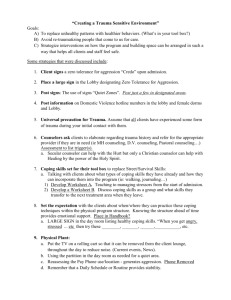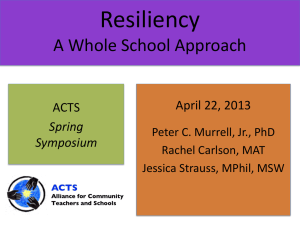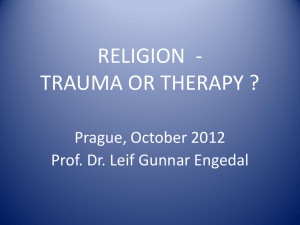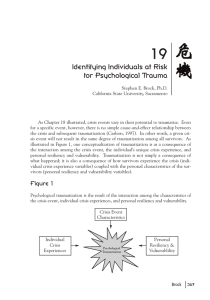Workshop 2 - The Crisis Intervention Association of Pennsylvania
advertisement
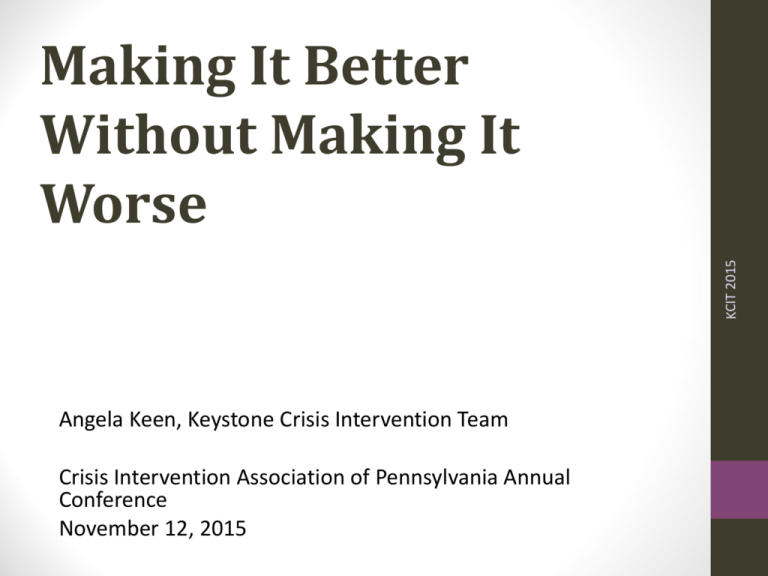
KCIT 2015 Making It Better Without Making It Worse Angela Keen, Keystone Crisis Intervention Team Crisis Intervention Association of Pennsylvania Annual Conference November 12, 2015 • Describe the neurobiology of trauma reactions • Idenitfy how empathy contributes to traumatic stress reactions that may be categorized as vicarious victimization, compassion fatigue and burnout • Recognize their own traumatic exposure responses and learn self-soothing techniques to build resiliency and healthy coping skills KCIT 2015 Attendees will be able to: Individual Trauma: A “blow to the psyche that breaks through one’s defenses so suddenly and with such force that one cannot respond effectively.” - Kai Erickson, In the Wake of a Flood, 1979 Collective Trauma: A “blow to the tissues of social life that damages the bonds attaching people together.” - Kai Erickson, In the Wake of a Flood, 1979 KCIT 2015 Trauma KCIT 2015 Trauma is any event that leaves a person feeling hopeless, helpless, fearing for their life and/or their safety. KCIT 2015 Fluctuating Equilibrium KCIT 2015 Impact of Trauma on Equilibrium Remember… KCIT 2015 • Trauma is a sensory experience • It is not cognitive! Sensory Path in the Non- Traumatized Brain Thalamus Amygdala Hippocampus KCIT 2015 Cortex- Neo Cortex Sensory Path in the Traumatized Brain Thalamus Amygdala Hippocampus KCIT 2015 Cortex- Neo Cortex During a Traumatic Event • Right Brain • Memory • Sensory • Affect Regulation Left Brain • • • • • Making Sense Problem Solving Decision Making Language Impulse Control KCIT 2015 The pathways between the right and left brain experience a disconnect. Remember… KCIT 2015 • Trauma is a sensory experience • It is not cognitive! • Feeling internally connected over time to caring others • Experiencing oneself as deserving and worthwhile • Managing Feelings: Recognize, tolerate, modulate, integrate feelings KCIT 2015 TRAUMA IMPAIRS KCIT 2015 POTENTIAL IMPACT OF REPEATED TRAUMA KCIT 2015 POTENTIAL IMPACT OF REPEATED TRAUMA Shifts people away from emotional safety, emotional balance and predictability. Disrupts the ability to return-to-center. KCIT 2015 TRAUMATIC STRESS 16 KCIT 2015 Stress Reactions of Caregivers KCIT 2015 Burnout: a chronic state of stress 17 • Exhaustion of mind and body • Frustration, cynicism, negative thoughts • Feelings of ineffectiveness and lack of accomplishment KCIT 2015 Signs of Burnout 18 • Emotional and physical drain of providing continual empathy • Ambiguous successes • Erosion of idealism • Lack of expected rewards KCIT 2015 Contributing Factors to Burnout 19 • Your health (poor sleep, illness) • Your personal life • Maintaining self-care • Job performance • Cognitive abilities (concentration, problem solving, decision making) KCIT 2015 Burnout Causes Havoc with: 20 Vicarious Victimization • A recent or similar trauma in the caregiver’s life (does not have to be directly related to the current disaster) • Similarities between victim and caregiver • Physical and emotional fatigue KCIT 2015 • Counter-transference 21 Compassion Fatigue • Listening to the story of the event • Through empathetic contact with victims or survivors • When they can’t distance themselves from the event KCIT 2015 • Caregivers experience trauma by: 22 Taking Care of Ourselves • Emotionally • Physically • Spiritually KCIT 2015 • What activities do you do to take care of yourself? • Identify your support system • Personal life • At work 23 KCIT 2015 Exercise 24 KCIT 2015 Nutrition 25 KCIT 2015 Humor 26 KCIT 2015 RESILIENCY AND COPING 27 Resilience refers to a person’s inherent capacity to moderate and recover from traumatic experience. KCIT 2015 RESILIENCY 28 RESILIENCY Prevent stress related disorders Recover faster Maintain peak performance Perform optimally during a crisis KCIT 2015 Helps to: 29 Everyone has some Skills can be taught and learned Starts in childhood It’s never too late to learn One can prepare for specific, expected crises KCIT 2015 RESILIENCY ASSUMPTIONS 30 Resiliency Factors Emotional Behavioral KCIT 2015 Attitudinal 31 • • • • • • • • • • Easy temperament Social competence Creative problem-solving skills Ability to tolerate frustration and manage emotions Clear and consistent boundaries Belief in one’s effectiveness Persistence in the face of failure Optimistic outlook Ability to build friendships and seek out support Sense of humor KCIT 2015 Resiliency Traits Include: KCIT 2015 Latipha Cross : A Story of Resiliency 33 1. What resources have you relied upon since the event that has supported your recovery? 2. Identify individual, family and community resources which could support your recovery? 3. What personal strengths have you utilized to assist in your recovery? 4. Are there things you can learn now to improve your recovery? 5. What steps can you take to achieve a sense of recovery? KCIT 2015 What are your sources of resiliency? 34 6. What can you identify as steps to take to achieve your family’s recovery? 7. What steps can you take to help your community achieve its recovery? 8. What will resiliency look like for you, your family, your community? 9. What needs have you identified since the event? KCIT 2015 What are your sources of resiliency? 35 KCIT 2015 Community Resilience 36 Page 371 Expending conscious effort to solve or tolerate personal or interpersonal problems, stress or conflict. KCIT 2015 Coping Skill The ability to do something from training, experience, or practice. 37 Why Teach Coping Skills? A. Define the problem B. Try to solve the problem C. Try to live with the problem D. Try to hide from the problem E. Quit trying all together KCIT 2015 When faced with a problem people first: Coping skills are used in helping people try to solve the problem and live with the problem 38 KCIT 2015 Why Teach Coping Skills 39 Coping Avoidant Coping seeks to keep the situation out of awareness KCIT 2015 Active Coping thinks about a situation to improve or adjust to it 40 KCIT 2015 Types of Coping 41 Defense Mechanisms 4 Square Breathing Deep Muscle Relaxation Thought Stopping Journaling Mindfulness Distraction Guided Imagery Exercise Pets Cognitive Restructuring Relaxation Techniques Self Nurturing Prayer Problem Solve Humor Meditation Music Volunteering Sharing (Venting) Letter or Recording to Self Positive Affirmations Art KCIT 2015 SPECIFIC SKILLS 42 Preparation, Preparation, Preparation 1) Outline healthy behaviors to help prevent crises. 2) Identify risk factors that may increase stress. 3) Identify symptoms that indicate a problem may be approaching. 4) Outline what to do in a crisis situation. KCIT 2015 4 Elements of a Safety Plan 43 Wrap Up KCIT 2015 We all use skills to get us through the rough times. What other ideas do you have? 44 45 KCIT 2015


